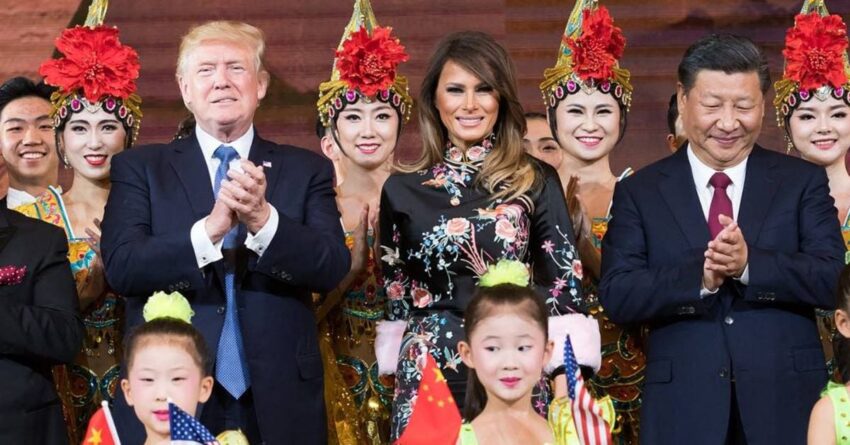The United States and China have once again announced a trade agreement aimed at de-escalating their longstanding economic tensions. This latest deal, however, raises more questions than it answers among top analysts, leaving critical issues unresolved between the world’s two largest economies.
Trade War with China

President Donald Trump recently announced that a deal with China had been signed “the other day.” In a subsequent confirmation, China’s Commerce Ministry echoed the sentiment, noting that some sort of arrangement had indeed been established. Yet, specifics remain shrouded in ambiguity. Voters have grown accustomed to the erratic shifts that characterize Trump’s trade policy, a strategy marked by sudden proclamations and a lack of transparent details since he assumed office, as he seeks to reshape what he considers an unjust global trading system. Trump has been engaged in a prolonged battle with China, which has exposed the economic pain each country can unleash upon the other as they navigate complex trade dynamics. As a deadline to finalize agreements with other key U.S. trading partners looms, the lack of clarity surrounding the recent pact has only heightened anxiety over the national economic outlook.
China’s Restrictions

The scope of the agreement centers on concessions from China aimed at facilitating American access to vital resources necessary for manufacturing and microchip production, specifically magnets and rare earth minerals. U.S. Treasury Secretary Scott Bessent remarked on Fox Business Network’s Mornings with Maria, affirming that the Chinese had made commitments to ease these restrictions. However, details remained sparse, as the Chinese Commerce Ministry mentioned only that “China will, in accordance with the law, review and approve eligible export applications for controlled items.” A White House official stated that the deal allows the U.S. to charge a 55% tariff on imported Chinese goods. This includes a 10% baseline “reciprocal” tariff, a 20% tariff for fentanyl trafficking and a 25% tariff reflecting pre-existing tariffs. China would charge a 10% tariff on U.S. imports. There was no explicit reference to whether the U.S. would lift any of its longstanding export controls on advanced technological goods to China.
Experts React

Gene Goldman, the Chief Investment Officer at Cetera Investment Management, claimed, “Equity markets breathed a sigh of relief on news of a potential U.S.-China trade deal. However, I would take this news with a bit of caution. While President Trump indicated that imports from China would rise from 30% to 55% and Chinese rare-earth exports may resume, there is little news on what China gets in return. I doubt this is a one-way deal and hence the market caution seen overnight.” Sam Stovall, the Chief Investment Strategist for CFRA Research also told outlets, “We’ve seen a relatively muted reaction to the news of a ‘deal’ with China, and to me that signals indifference. It says, OK, you have agreed to continue talking and set up a framework for future talks, but nothing all that significant has really been resolved. … The market is saying, ‘Tell me something worth knowing about.’ And we all know that if we don’t have a comprehensive solution, it’s not going to be good. It would mean we have to purchase our 30 dolls for Christmas somewhere else, which will be much more expensive. This is just my own reading of this, but in the face of better-than-expected inflation numbers today, the market is struggling to hold onto its gains and I can only think that it’s that people needed to see more from the China talks. Perhaps investors sold on strength, out of the opinion that we’re overbought at this stage.”
The Trade Deal

So, how did the two powers find themselves in a position to announce yet another trade deal? This most recent arrangement builds on a framework established on June 11, when Trump indicated that an easing of restrictions on rare earths had been agreed upon after extensive talks in London. The U.S. also backed off from attempts to revoke visas for Chinese students enrolled in U.S. colleges, which has been controversial amidst rising tensions. Despite this apparent gesture, the fundamental issues at the heart of U.S.-China relations remain unresolved. Global markets reacted cautiously to the announcement of the agreement, a continuation of a trend where the economic interdependence between the two nations complicates diplomatic relations.
The post Top Analysts React to US-China Trade Agreement appeared first on Knewz.
Click this link for the original source of this article.
Author: Joshua Wilburn
This content is courtesy of, and owned and copyrighted by, https://knewz.com and its author. This content is made available by use of the public RSS feed offered by the host site and is used for educational purposes only. If you are the author or represent the host site and would like this content removed now and in the future, please contact USSANews.com using the email address in the Contact page found in the website menu.







